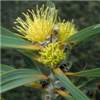 Photo © I.Holliday |
 Photo © W.R.Barker |
 Photo © W.R.Barker |
 Photo © W.R.Barker |
 Illustration of H. tricostata (= H. cinerea) from Hooker's Icones Plantarum t. 442 (1842). |
Synonymy
Hakea cinerea R.Br., Trans. Linn. Soc. London 10: 186 (1810)
T: Lewins land in arenosis prope littora, Bay I, [Lucky Bay, W. A.], [?7 Jan. 1802], R.Brown Iter Austral. 31; syn: B, BM, E, G, K p.p., P.
?Hakea canescens Link, Enum. Pl. Hort. Reg. Berol. 1: 118 (1821). T: 'in Australia', not located.
Hakea tricostata R.Br. ex Hook., Icon. Pl. 5: t. 436 (1842). T: King George Sound, [W.A.], s.d., W.Baxter s.n.; syn: K; Illustration accompanying protologue shown here.
Description
Erect shrub, 0.7–2.4 m tall, possibly lignotuberous. Leaves ±uniform, alternate, ±rigid, flat or shallowly concave, narrowly obovate to linear, 6–16 cm long, 8–18 mm wide, entire, acute to acuminate, grey-green; longitudinal veins prominent, 1–3 above, 3–6 below; pinnate veins visible but often obscure.
Inflorescence with 40–56 flowers; pedicels 4–6 mm long, glabrous. Perianth yellow, splitting into 4 free segments. Pistil 22–23 mm long; gland U-shaped.
Fruit 1–5 per axil, obliquely narrowly ovate, 2.2–2.5 cm long, 0.6–0.9 cm wide, not beaked, not apiculate, not corky. Seed obliquely narrowly ovate, 12–13 mm long, 4–5 mm wide; wing extending narrowly down both sides of body, dark grey-brown, sometimes with blackish patches.
Distribution and ecology
Occurs along the southern coastal region of W.A. from Ravensthorpe to Israelite Bay and up to c. 70 km inland, with a slightly disjunct occurrence at Point Culver at the west end of the Great Australian Bight. Generally found in mallee-heath or low heath communities in white or pale sandy soil, sometimes in swampy situations.
To plot an up to date distribution map based on herbarium collections for this species see Australia's Virtual Herbarium. Localities outside the native range may represent cultivated or naturalised records.
Flowering time
Flowers Aug.–Nov.
Derivation of name
From cinereus, Latin for ash-grey, a reference to the overall appearance of the bushes of this species.
Relationships
Part of Sect. Conogynoides recognised by Bentham (1870) and characterised by a conical pollen presenter, veined leaves, glabrous perianth and fruits without horns.
Members of the group are H. acuminata, H. cinerea, H. corymbosa, H. eneabba and H. victoria, all from SW WA.
Representative specimens
W.A.: scenic lookout, Hopetoun, E.M.Bennett 2563 (PERTH); c. 80 km E of Esperance, R.H.Kuchel 1645 (AD, L, PERTH, UC, W); c. 3 km NE of Howick Hill, A.E.Orchard 1115 (AD, CANB, PERTH).
Weblinks
Link to FloraBase treatment of this species for WA.
For further information and images of this species in the Esperance region of Western Australia see William Archer’s Hakea page in Esperance Wildflowers
More photographs of this species can be seen on the Australian National Botanic Gardens site.
Further illustrations
J.W.Wrigley & M.Fagg, Banksias, Waratahs & Grevilleas 366 (1989).
I. Holliday, Hakeas. A Field and Garden Guide 36-37 (2005)
J.A..Young, Hakeas of Western Australia. A Field and Identification Guide 23 (2006)